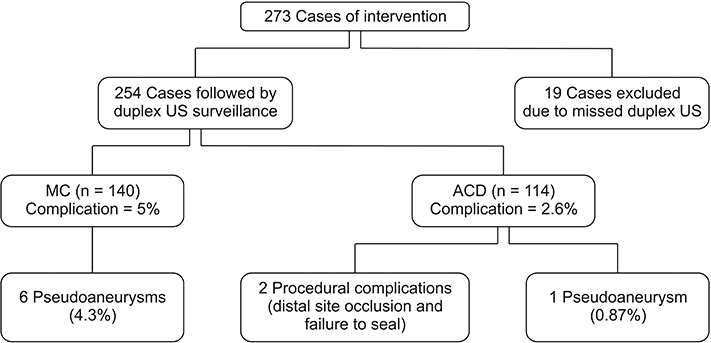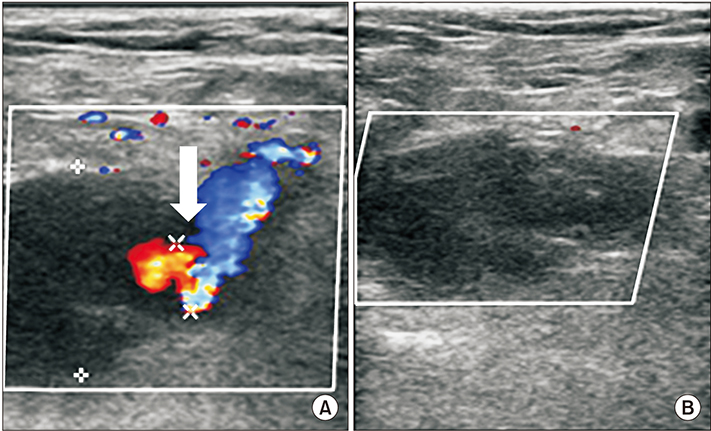Ann Surg Treat Res.
2019 Jun;96(6):305-312. 10.4174/astr.2019.96.6.305.
Access site pseudoaneurysms after endovascular intervention for peripheral arterial diseases
- Affiliations
-
- 1Department of Surgery, Seoul National University Bundang Hospital, Seongnam, Korea. tslee@snubh.org
- 2Department of Vascular Surgery, Faculty of Medicine, Mansoura University Hospital, Mansoura, Egypt.
- 3Department of Surgery, Seoul National University College of Medicine, Seoul, Korea.
- KMID: 2447955
- DOI: http://doi.org/10.4174/astr.2019.96.6.305
Abstract
- PURPOSE
Pseudoaneurysms after percutaneous vascular access are common and potentially fatal if left untreated. The aim of this study was to determine the incidence and risk factors associated with access site pseudoaneurysms after endovascular intervention for peripheral arterial disease (PAD) under a routine postintervention ultrasound (US) surveillance protocol.
METHODS
A total of 254 PAD interventions were performed in a single center between January 2015 and November 2016, and puncture site duplex US surveillance was routinely performed within 48 hours of the procedure. Clinical, procedural and follow-up US data were analyzed.
RESULTS
The overall incidence of pseudoaneurysm was 2.75% (6 cases in the femoral artery and 1 in the brachial artery). There was no difference between retrograde and antegrade approach, but there was a higher rate of pseudoaneurysm formation after manual compression compared to arterial closure device (ACD) use (4.3% vs. 0.87%). Manual compression was more commonly used for antegrade punctures (79.0%) and ACD for retrograde punctures (67.7%). Calcification was more frequently found in antegrade approach cases (46.8% vs. 16.9% for retrograde cases) and manual compression was preferred in its presence. All pseudoaneurysms were treated successfully at the time of diagnosis by US-guided compression repair and there were no cases of rupture.
CONCLUSION
Pseudoaneurysm rates after therapeutic endovascular intervention for PAD were comparable to other cardiologic or interventional radiologic procedures despite the higher possibility of having a diseased access vessel. Routine US surveillance of access sites allowed for early diagnosis and noninvasive treatment of pseudoaneurysms, preventing potentially fatal complications.
Keyword
MeSH Terms
Figure
Reference
-
1. European Stroke Organisation. Tendera M, Aboyans V, Bartelink ML, Baumgartner I, Clement D, et al. ESC Guidelines on the diagnosis and treatment of peripheral artery diseases: document covering atherosclerotic disease of extracranial carotid and vertebral, mesenteric, renal, upper and lower extremity arteries: the Task Force on the Diagnosis and Treatment of Peripheral Artery Diseases of the European Society of Cardiology (ESC). Eur Heart J. 2011; 32:2851–2906.2. Waksman R, King SB 3rd, Douglas JS, Shen Y, Ewing H, Mueller L, et al. Predictors of groin complications after balloon and new-device coronary intervention. Am J Cardiol. 1995; 75:886–889.
Article3. Omoigui NA, Califf RM, Pieper K, Keeler G, O'Hanesian MA, Berdan LG, et al. Peripheral vascular complications in the Coronary Angioplasty Versus Excisional Atherectomy Trial (CAVEAT-I). J Am Coll Cardiol. 1995; 26:922–930.
Article4. Fransson SG, Nylander E. Vascular injury following cardiac catheterization, coronary angiography, and coronary angioplasty. Eur Heart J. 1994; 15:232–235.
Article5. Moll R, Habscheid W, Landwehr P. The frequency of false aneurysms of the femoral artery following heart catheterization and PTA (percutaneous transluminal angioplasty). Rofo. 1991; 154:23–27.6. Madigan JB, Ratnam LA, Belli AM. Arterial closure devices. A review. J Cardiovasc Surg (Torino). 2007; 48:607–624.7. Koreny M, Riedmuller E, Nikfardjam M, Siostrzonek P, Müllner M. Arterial puncture closing devices compared with standard manual compression after cardiac catheterization: systematic review and meta-analysis. JAMA. 2004; 291:350–357.
Article8. Rocha-Singh KJ, Zeller T, Jaff MR. Peripheral arterial calcification: prevalence, mechanism, detection, and clinical implications. Catheter Cardiovasc Interv. 2014; 83:E212–E220.
Article9. Coley BD, Roberts AC, Fellmeth BD, Valji K, Bookstein JJ, Hye RJ. Postangiographic femoral artery pseudoaneurysms: further experience with US-guided compression repair. Radiology. 1995; 194:307–311.
Article10. Ricci MA, Trevisani GT, Pilcher DB. Vascular complications of cardiac catheterization. Am J Surg. 1994; 167:375–378.
Article11. McCleary AJ, Raptis S. Closing the loop: the role of audit in reducing groin complications associated with coronary angiography. Clin Radiol. 2001; 56:917–921.
Article12. Nikolsky E, Mehran R, Halkin A, Aymong ED, Mintz GS, Lasic Z, et al. Vascular complications associated with arteriotomy closure devices in patients undergoing percutaneous coronary procedures: a meta-analysis. J Am Coll Cardiol. 2004; 44:1200–1209.
Article13. Das R, Ahmed K, Athanasiou T, Morgan RA, Belli AM. Arterial closure devices versus manual compression for femoral haemostasis in interventional radiological procedures: a systematic review and meta-analysis. Cardiovasc Intervent Radiol. 2011; 34:723–738.
Article14. Silber S. Hemostasis success rates and local complications with collagen after femoral access for cardiac catheterization: analysis of 6007 published patients. Am Heart J. 1998; 135:152–156.
Article15. Stone PA, Campbell JE, AbuRahma AF. Femoral pseudoaneurysms after percutaneous access. J Vasc Surg. 2014; 60:1359–1366.
Article16. Mlekusch W, Haumer M, Mlekusch I, Dick P, Steiner-Boeker S, Bartok A, et al. Prediction of iatrogenic pseudoaneurysm after percutaneous endovascular procedures. Radiology. 2006; 240:597–602.
Article17. Hoke M, Koppensteiner R, Schillinger M, Haumer M, Minar E, Wiesbauer F, et al. D-dimer testing in the diagnosis of transfemoral pseudoaneurysm after percutaneous transluminal procedures. J Vasc Surg. 2010; 52:383–387.
Article18. Fellmeth BD, Roberts AC, Bookstein JJ, Freischlag JA, Forsythe JR, Buckner NK, et al. Postangiographic femoral artery injuries: nonsurgical repair with US-guided compression. Radiology. 1991; 178:671–675.
Article19. Schaub F, Theiss W, Busch R, Heinz M, Paschalidis M, Schomig A. Management of 219 consecutive cases of postcatheterization pseudoaneurysm. J Am Coll Cardiol. 1997; 30:670–675.
Article20. Khoury M, Rebecca A, Greene K, Rama K, Colaiuta E, Flynn L, et al. Duplex scanning-guided thrombin injection for the treatment of iatrogenic pseudoaneurysms. J Vasc Surg. 2002; 35:517–521.
Article21. Ates M, Sahin S, Konuralp C, Gullu U, Cimen S, Kizilay M, et al. Evaluation of risk factors associated with femoral pseudoaneurysms after cardiac catheterization. J Vasc Surg. 2006; 43:520–524.
Article22. Gutzeit A, van Schie B, Schoch E, Hergan K, Graf N, Binkert CA. Feasibility and safety of vascular closure devices in an antegrade approach to either the common femoral artery or the superficial femoral artery. Cardiovasc Intervent Radiol. 2012; 35:1036–1040.
Article23. Boschewitz JM, Pieper CC, Andersson M, Nadal J, Schild HH, Meyer C. Efficacy and time-to-hemostasis of antegrade femoral access closure using the ExoSeal vascular closure device: a retrospective single-center study. Eur J Vasc Endovasc Surg. 2014; 48:585–591.
Article24. Chiu AH, Coles SR, Tibballs J, Nadkarni S. The StarClose vascular closure device in antegrade and retrograde punctures: a single-center experience. J Endovasc Ther. 2010; 17:46–50.
Article25. Spiliopoulos S, Katsanos K, Karnabatidis D, Diamantopoulos A, Nikolaos C, Siablis D. Safety and efficacy of the StarClose vascular closure device in more than 1000 consecutive peripheral angioplasty procedures. J Endovasc Ther. 2011; 18:435–443.
Article26. Looby S, Keeling AN, McErlean A, Given MF, Geoghegan T, Lee MJ. Efficacy and safety of the angioseal vascular closure device post antegrade puncture. Cardiovasc Intervent Radiol. 2008; 31:558–562.
Article
- Full Text Links
- Actions
-
Cited
- CITED
-
- Close
- Share
- Similar articles
-
- Angiographic Insights and Endovascular Intervention in Pulmonary Artery Pseudoaneurysms: A Comprehensive Clinical and Pictorial Essay
- Delayed Bilateral Common Femoral Pseudoaneurysm after Percutaneous Access with Interventional Management: A Case Report
- A Case of Successful Treatment of Huge Pseudoaneurysm Complicated with Endovascular Intervention Using Thrombin Injection
- Endovascular Revascularization for Aortoiliac Occlusive Disease
- Endovascular Management of Immediate Procedure-Related Complications of Failed Hemodialysis Access Recanalization



